There is no sea rise in the Maldives
The Maldives, an island chain to the south west of Sri Lanka, are very low-lying. In 2007, the UN's Intergovernmental Panel on Climate Change warned that a rise in sea levels of seven to 24 inches by 2100 would be enough to make the Maldives virtually uninhabitable. In October 2009, the Maldives government held a cabinet meeting under the sea in scuba gear "to attract international attention to the dangers of global warming". This publicity stunt was to highlight, so they said, the threat of rising sea levels caused by man-made global warming.
On 31 December 2009, the Daily Mail published a letter from a reader. It read:
Is this a sea change?
DR NILS-AXEL MORNER, former head of paleogeophysics and geodynamics at Stockholm University and leader of the Maldives Sea Level Project, says he found the sea level round the Maldives had risen by about 1mm a year between 1850 and 1940. After that, here was no change until 1970, when the sea level fell by about 20cm and hasn't changed since in the past 35 years.
Using satellite altimetry, Dr Morner showed there was no trend in the change in sea-level around the globe. The IPCC report showing a rise of 2.3mm in 2003 was because fictional 'data' had been used. When he was about to leave the Maldives, Dr Morner made a programme for Maldives TV re-assuring residents that the sea level wasn't rising. The Maldives government banned the broadcast: it would have meant losing money from Western governments.
A tree on an island that had been there since 1950 was pulled down by an Australian (pro-IPCC) sea level team because it was clear evidence that the sea-level wasn't rising. According to Dr Morner, true sea level specialists agree there might be a rise of 10cm (plus or minus 10cm) in 100 years, but this is at odds with current 'official' reports of a rise of 30ft.
Who do we believe? A scientist eminent in his field or a team whose funding depends giving the 'correct' answer?
Politicians shouldn't be misled by dodgy reports which haven't been independently reviewed.
EDDIE YOUNGER, Blackburn, West Lothian.
A bit of research point to the 'threat' really being a fraud, perpetrated by the Maldivians, supported by IPCC pronouncements, to extort money from the 'polluting countries'.
Below is a written memorandum to the UK Parliament Select Committee on Economic Affairs dated 30 March 2005 from a leading scientist, Professor Nils-Axel Mörner, with special interest in the Maldives.
Climate is becoming increasingly warmer we hear almost every day. This is what has become known as Global Warming. The driving idea is that there is a linear relationship between CO2 increase in the atmosphere and global temperature. The fact, however, is that temperature has constantly gone up and down. From 1850 to 1970, we see an almost linear relationship with Solar variability; not CO2. For the last 30 years, our data sets are so contaminated by personal interpretations and personal choices that it is almost impossible to sort up the mess in reliable and unreliable data.
Most remarkable in the record of climatic changes during the last 600 years are the cold periods around 1450, 1690 and 1815 and their correlation with periods of Solar Minima (the Spörer, Maunder and Dalton Solar Minima). The driving cyclic solar forces can easily be extrapolated into the future. This would call for a new cold period or "Little Ice Age" to occur at around 2040-50. Still, we hear nothing about this. It is as if IPCC and the Kyoto Protocol enthusiasts want to "switch off the Sun itself". Let us take this, at least, as a piece of information to rise our awareness and curiosity.
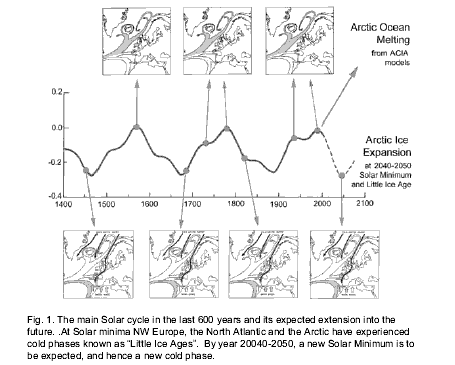
In the global warming concept, it has been constantly claimed that there will be a causal rise in sea level; a rise that already is in the accelerating mode, in the near future to cause extensive and disastrous flooding of low-lying coastal areas and islands. "It will be the death of our nation", says the President of the Maldives, and the people of Tuvalu in the Pacific claim that the flooding has already commenced.
Is this facts or fiction? It is true that we are flooded by this information. But what lies behind this idea? And, especially, what do the true international specialists think?
The recording and understanding of past changes in sea level, and its relation to other changes (climate, glacial volume, gravity potential variations, rotational changes, ocean current variability, evaporation/precipitation changes, etc) is the key to sound estimates of future changes in sea level.
The international organisations hosting the true specialists on sea level changes are to be found with the INQUA commission on sea level changes and the IGCP special projects on sea level changes. When I was president of the INQUA Commission on Sea Level Changes and Coastal Evolution, 1999-2003, we paid special attention just to this question; ie proposed rise in sea level and its relation to observational reality. We discussed the issue at five international meetings and by Webb-networking. Our opinion is illustrated in Fig 2. In view of the Fig 1 prediction, I have later revised the estimate for year 2100 to: +5 cm ± 15 cm./p>
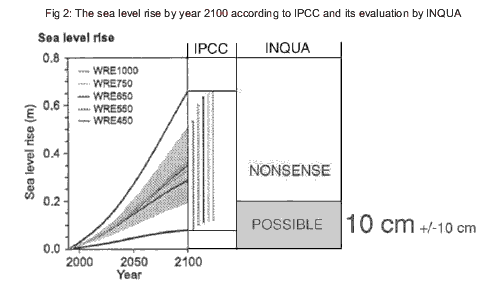
Prior to 5000-6000 BP, all sea level curves are dominated by a general rise in sea level in true glacial eustatic response to the melting of continental ice caps. In the last 5,000 years, global mean sea level has been dominated by the redistribution of water masses over the globe. In the last 300 years, sea level has been oscillating close to the present level, with peak rates in the period 1890-1930 (Fig 3).
It is true that sea level rose in the order of 10-11 cm from 1850 to 1940 as a function of Solar variability and related changes in global temperature and glacial volume. From 1940 to 1970, it stopped rising, maybe even fell a little. In the last 10-15 years, we see no true signs of any rise or, especially, accelerating rise (as claimed by IPCC), only a variability around zero. This is illustrated in Fig 3.
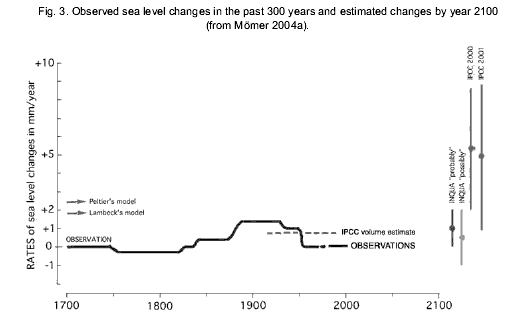
With the TOPEX/POSEIDON satellite mission in 1992, we now have new means of recording actual sea level changes. The record from 1992 to early 2000 (Fig 4) lacks any sign of a sea level rise; it records variability around zero plus a major ENSO even in year 1997.
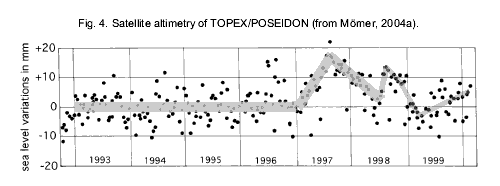
When we three years later have the same record extended into year 2003 on the Webb, a tilt has been introduced. This tilt does not originate from the satellite altimetry readings, however, but represents an inferred factor from tide-gauge interpretations. In order to get back to true satellite data, we have to tilt the whole record back to its original data of Fig 4. When this is done, there is no sea level rise to be seen—only a variability around zero plus a number of high-amplitude ENSO oscillations (Fig 5). This is why I in Fig 3 conclude that the sea level remained stationary at around zero for the last 10-15 years (as further discussed in Mörner, 2004a and 2005).
The tide-gauge introduced into the satellite data on the Webb seems to violate observational facts at sites spread all over the globe; not least our NW European data covering both uplifted areas (Fennoscandia, Scotland) as subsiding areas (the North Sea).
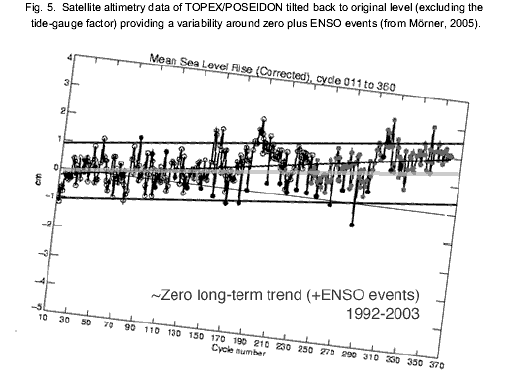
From 2000 to the present, we have run a special international sea level project in the Maldives including six field sessions and numerous radiocarbon dates. Our record for the last 1,200 years is given in Fig 6. There are no signs of any on-going sea level rise. It seems all to be a myth.
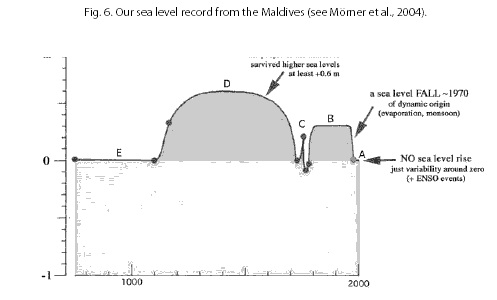
Tuvalu in the Pacific is often said already to be in the flooding mode. The tide-gauge record (Fig 7) for the last 25 years does not show any rise, however. The truth seems to be that a Japanese pineapple industry had subtracted too much freshwater by that forcing saltwater to invade the subsurface.

Fig 7. The Tuvalu tide-gauge record 1978-2003 showing stability around a zero level plus three negative ENSO events (from Mörner, 2004c).
Venice is notorious for its flooding problems. It lies on a delta area subjected to subsidence. Therefore, the sea level variations are superposed on a long-term subsidence trend (Fig 8). Any rise in sea level would immediately worsen the situation. The last 30 years lack signs of any rise or accelerated rise, on the contrary sea level fell (partly as a function of engineering work).

Fig 8. Observes sea level changes (purple) superposed on a long-term subsidence trend (blue). At 1970 (green arrow), there is a marked change in tendency, partly due to engineering work, but certainly seriously contradicting a sea level rise and especially an accelerated sea level rise.
In conclusion; observational data do not support the sea level rise scenario. On the contrary, they seriously contradict it. Therefore, we should free the world from the condemnation of becoming extensively flooded in the near future.
There are more urgent natural problems to consider on Planet Earth like tsunamis, earthquakes, volcanic eruptions, etc.
30 March 2005
Some recent scientific papers by the author
The INQUA Commission—www.pog.su.se/sea
Authors homepage—www.pog.su.se.
Mörner, N-A, 2005. Sea level changes and crustal movements with special aspects on the eastern Mediterranean. Z Geomorph. NF, Suppl Vol 137, p 91-102.
Mörner, N-A, 2004d. Changing Sea Levels. In: Encyclopedia of Coastal Science (M Schwartz, Ed), p 284-288.
Mörner, N-A, 2004c. Sea level change: Are low-lying islands and coastal areas are under threat? In: "The impacts of climate changes. An appraisal for the future", p 29-35. International Policy Press.
Mörner, N-A, 2004b. The Maldives Project: a future free from sea level flooding. Contemprary South Asia, 13 (2), p 149-155.
Mörner, N-A, 2004a. Estimating future sea level changes. Global Planet. Change, 40, 49-54.
Mörner, N-A, Tooley, M & Possnert, G, 2004. New perspectives for the future of the Maldives. Global Planet. Change, 40, 177-182.
Mörner, N-A, 2002. Livello dei mari e clima (Sea Level Changes and Climate). Nuova Secondaria, 10/2002, p 43-45.
Mörner, N-A, 2001. Global and local sea level changes: the interaction of multipleparametres (hydrosphre, cryosphere, lithosphere, ocean dynamics and climate). Schr. Deutschen Geol. Gesellschaft, 14, 3-4.
Mörner, N-A, 2000b. Sea level changes in western Europe. Integrated Coastal Zone Management, Autumn 2000 Ed, p 31-36, ICG Publ. Ltd.
Mörner, N-A, 2000a. Sea level changes and coastal dynamics in the Indian Ocean. Integrated Coastal Zone Management, Spring 2000 Ed, p 17-20, ICG Publ. Ltd.
Mörner, N-A, 1999. Sea level and climate. Rapid regressions at local warm phases. Quaternary International, 60, 75-82.
Mörner, N-A, 1996b. Rapid changes in coastal sea level. J. Coastal Res, 12, 797-800.
Mörner, N-A, 1996a. Sea Level Variability. Z Geomorphology NS, 102, p 223-232.
Mörner, N-A, 1995. Earth rotation, ocean circulation and paleoclimate. GeoJournal, 37, 419-430.
Mörner, N-A, 1995b. Recorded sea level variability in the Holocene and expected future changes. In: Climatic Change: Impacts on Coastal Habitation (D Eisma, Ed), pp 17-28.
Mörner, N-A, 1995a. Sea Level and Climate—The decadal-to-century signals. J Coastal Res., Sp I 17, 261-268.
Plus numerous sea level papers in the period 1969-95.
See also:
Lars Mortensen, 2004; Doomsday Called Off, TV-documentary, Danish TV, Copenhagen.
Last updated 1 January 2010
Related Articles

 HOME
HOME


